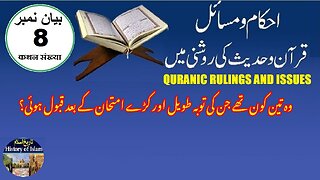Premium Only Content

Part-5 History of Roza Rasool and Masjid Nabwi روضہ رسول اور مسجد نبوی صلی اللہ علیہ وسلم کی تاریخ
@islamichistory813 #TombOfTheProphetMuhammad #SacredChamber #IslamicHistory #Madina
Part-5
History of Roza Rasool and Masjid Nabwi (Peace be upon Him)
Asslamoalaikum sisters brothers friends and elders, We are contineu going to start describing from where yesterday we was stop describing the Tomb (Roza Rasool) of the Prophet Muhammad SAW (The Sacred Chamber, its is fifth part of topic.
The Sultan chose one of the greatest scholars of the time, Ali ibn Ahmad al-Samhudi V, to clean the Sacred Chamber. For the first time in at least 500 years, a person was reported to have entered the inner chamber where the Prophet ? and his two companions were resting. Al-Samhudi, who later authored extensive works about Madinah and the life of the Prophet ?, describes his blessed experience. He wrote in his book, Wafa al-Wafa:
As I enter the blessed room from the rear, I did not go any further. I detected a fragrance the likes of which I had never before perceived. I stood there as long as I could, giving salaam to the best of all prophets, and then to the closest of his two companions, and I made as many supplications as I could. I saw that the room was now flat, so no longer could the graves be seen, except for one mound in the back which I assumed was the grave of Umar. I touched the gravel on the ground and it was moist, as if it was fresh.15
Although there were no doors, Al-Samhudi may have entered the Sacred Chamber through a gap between the wall and the ground. He also mentioned that the ground in the Sacred Chamber was lower than the ground outside of it. He added that to get to the site of the grave, he had to go down at least three arms lengths.
It was during the restoration by Al-Ashraf Qaitbay that the wooden boundary fence, built by Al-Zahir Baybars 200 years earlier around the Prophet’s tomb, was replaced with metallic railing. This very railing still stands today, and it is outside this perimeter that visitors give salam to the Prophet ? and his companions. The Sultan also separated the house of Fatima J and the tomb of the Prophet ? within the Sacred Chamber.
He also rebuilt the wooden dome above the Sacred Chamber built by al-Mansur Qalawun after the fire had destroyed it. The new dome was made from carved stone and was built on a solid foundation. He then ordered a second dome to be built on top of it.
Additionally, the Sultan built another large wall around the pentagonal structure, which had sustained damage during the fire. This is the wall from which the ghilaf (cloth) hangs and was covered in marble.
In the Ottoman Era – 1228 AH (1813 CE)
During the reign of Ottoman Sultan Mahmud II V, the upper dome built by Sultan Qaitbay was replaced in 1228 AH (1813 CE). After cracks appeared in the dome, it was demolished and replaced with a dome made from bricks covered in sheets of lead. This dome was painted green two decades later by his successor Sultan AbdulMejid I V, and is now commonly referred to as the Green Dome.
The walls of the Prophet’s ? tomb were also covered with tiles. When work was carried out in the Sacred Chamber, every necessary precaution was taken to protect it from debris and dust.
Poetry Added to the Chamber – 1265 AH (1848 CE)
In the reign of Sultan AbdulMejid I, the 31st Sultan of the Ottoman Empire, the Sacred Chamber was adorned with poetry in praise of the Prophet ?. One of the poems was by K’ab ibn Zuhayr I, a companion of the Prophet ? which consists of 57 verses. The other poem was the famous Qasida Burda (Poem of the Mantle), composed by the great Imam al-Busiri V and consists of 164 verses.
Who is Imam al-Busiri?
Imam al-Busiri was a spiritual disciple of Abu al-Abbas al-Mursi, one of the great scholars and spiritual masters of his age. During the Imam’s life, half of his body became paralysed, so he decided to write a poem as a means of asking God for a cure through the intercession of the Prophet ?. During the time he wrote the poem, Imam al-Busiri had a dream that the Prophet ? came to him and heard him recite the poem. On hearing the poem, the Prophet ? became so pleased that he wrapped a cloak around the Imam, and when he woke up, he had been completely cured of the paralysis. Hence the poem was given the honorific title – the Burda (cloak).
Throughout the rule of the Ottomans, the Sacred Chamber, as well as Masjid Nabawi as a whole, was maintained splendidly and given the utmost respect.
Death of the Prophet ?
The Prophet ? passed away at the age of 63 after suffering from illness for a period of 14 days. The date of his death is said to be Monday 12th of Rabi al-Awwal 11 AH (633 CE) and occurred in mid-morning. He was buried two days later on Wednesday night.
As he neared death, he would dip his hand into a cup of water and wipe the water over his face whilst supplicating, “O Allah, help me overcome the pangs of death”. He would also cover his face with a blanket. His beloved wife Aisha J held him in her lap as he breathed his last. As he said his final words, with his eyes wide open staring towards the heavens, his head dropped down, and his soul departed.
Overcome with grief, she gently laid his blessed head down on a pillow and began to cry with the women of the house, who had just heard the news. Aisha J narrates her final moments with her husband:
When the Prophet ? was healthy, he used to say, ‘No soul of a prophet is seized until he is shown his place in Paradise and then he is given the option.’ When death approached him while his head was on my thigh, he became unconscious and then recovered consciousness. He looked at the ceiling of the house and said, ‘O Allah! (with) the highest companions.’ I said (to myself), ‘Hence, he is not going to choose us.’ Then I realised that what he had said was the application of the narration which he used to mention to us when he was healthy. The last word he spoke was, ‘O Allah! (with) the highest companions.’16
After his demise, the companions were in a complete state of shock. Umar I was in a state of denial, believing that the Prophet ? would wake up and threatening those who said the Prophet ? had died. Uthman was dumbfounded I and Ali I was unable to stand up. Abu Bakr and al-Abbas L remained calmer than anyone on the most tragic day the Muslim community had endured and ever will endure.
So dear friends, remaining history will be described from here in next video part-6. Allah Hafiz
=================================
-
 8:26
8:26
ISLAMIC HISTORY
23 hours agoWho were the three وہ تین کون تھے جن کی توبہ ایک طویل اور کڑے امتحان کے بعد قبول ہوئی؟
5 -
 26:39
26:39
Producer Michael
20 hours agoMY $32,000 EMIRATES FIRST CLASS FLIGHT!
43K6 -
 10:12
10:12
BlaireWhite
1 day agoWoke TikTokers Are SUPPORTING The Trans Shooter..
9.07K12 -
 48:21
48:21
The Confessionals
21 hours agoPossessed by the Gods? The Truth About Avatars w/ Jonathan Cahn
18.9K6 -
 36:34
36:34
The Finance Hub
18 hours ago $4.00 earnedBREAKING: BILL CLINTON'S EPSTEIN TIES JUST GOT RELEASED!!!
21.4K14 -
 2:02:14
2:02:14
BEK TV
1 day agoTrent Loos in the Morning - 9/10/2025
16.4K -
 LIVE
LIVE
The Bubba Army
23 hours agoFeds STEP IN on Charlotte Stabbing Case - Bubba the Love Sponge® Show | 9/10/25
1,661 watching -
 LIVE
LIVE
FyrBorne
12 hours ago🔴Warzone M&K Sniping: An Old Meta Returns To Cut Down The Competition
60 watching -
 25:54
25:54
ZeeeMedia
15 hours agoThe Shadow Government, Mask Plague, Nepal Uprising Topples Government | Daily Pulse Ep 104
25.5K28 -
 8:08:58
8:08:58
Biscotti-B23
8 hours ago $0.27 earned🔴 LIVE DRAGON BALL GEKISHIN SQUADRA IS HERE 🐉 RANKED MATCHES & BATTLE PASS SHOWCASE
11.9K